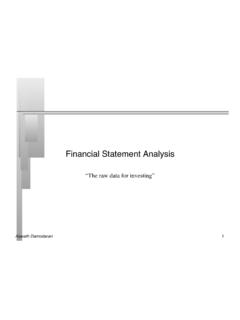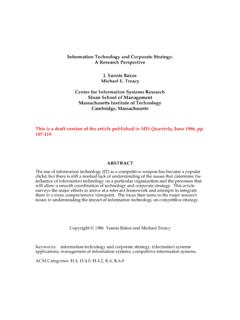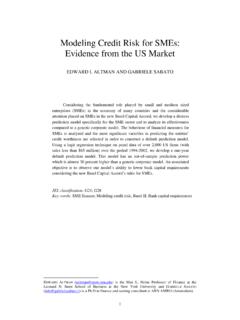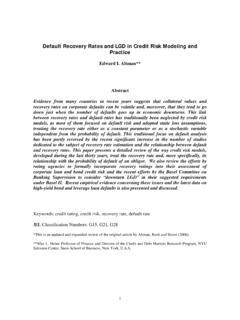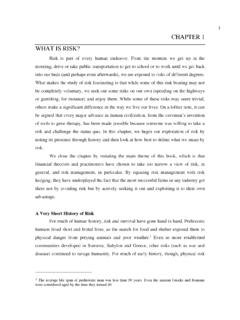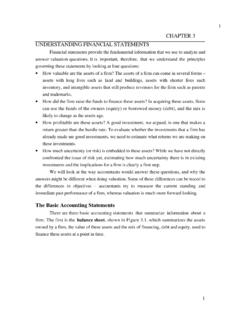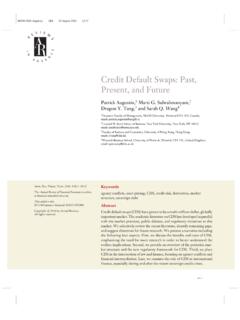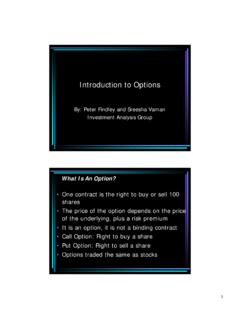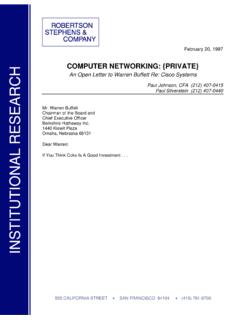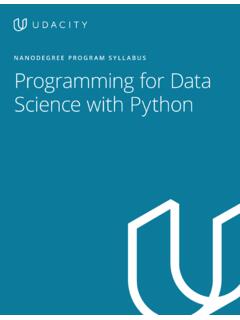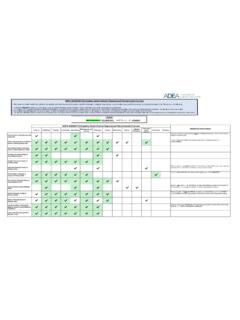Transcription of MULTIPLE REGRESSION BASICS - New York University
1 MULTIPLE REGRESSION BASICS . MULTIPLE REGRESSION BASICS . Documents prepared for use in course , New York University , Stern School of business introductory thoughts about MULTIPLE REGRESSION page 3. Why do we do a MULTIPLE REGRESSION ? What do we expect to learn from it? What is the MULTIPLE REGRESSION model? How can we sort out all the notation? Scaling and transforming variables page 9. Some variables cannot be used in their original forms. The most common strategy is taking logarithms, but sometimes ratios are used. The gross size concept is noted. Data cleaning page 11. Here are some strategies for checking a data set for coding errors. Interpretation of coefficients in MULTIPLE REGRESSION page 13.
2 The interpretations are more complicated than in a simple REGRESSION . Also, we need to think about interpretations after logarithms have been used. Pathologies in interpreting REGRESSION coefficients page 15. Just when you thought you knew what REGRESSION coefficients meant .. 1. MULTIPLE REGRESSION BASICS . REGRESSION analysis of variance table page 18. Here is the layout of the analysis of variance table associated with REGRESSION . There is some simple structure to this table. Several of the important quantities associated with the REGRESSION are obtained directly from the analysis of variance table. Indicator variables page 20. Special techniques are needed in dealing with non-ordinal categorical independent variables with three or more values.
3 A few comments relate to model selection, the topic of another document. Noise in a REGRESSION page 32. Random noise obscures the exact relationship between the dependent and independent variables. Here are pictures showing the consequences of increasing noise standard deviation. There is a technical discussion of the consequences of measurement noise in an independent variable. This entire discussion is done for simple REGRESSION , but the ideas carry over in a complicated way to MULTIPLE REGRESSION . Cover photo: Praying mantis, 2003. Gary Simon, 2003. 2. % % % % % % introductory THOUGHTS ABOUT MULTIPLE REGRESSION % % % % % %. INPUT TO A REGRESSION PROBLEM.
4 Simple REGRESSION : (x1, Y1), (x1, Y2), , (xn, Yn). MULTIPLE REGRESSION : ( (x1)1, (x2)1, (x3)1, (xK)1, Y1), ( (x1)2, (x2)2, (x3)2, (xK)2, Y2), ( (x1)3, (x2)3, (x3)3, (xK)3, Y3), , ( (x1)n, (x2)n, (x3)n, (xK)n, Yn), The variable Y is designated as the dependent variable. The only distinction between the two situations above is whether there is just one x predictor or many. The predictors are called independent variables.. There is a certain awkwardness about giving generic names for the independent variables in the MULTIPLE REGRESSION case. In this notation, x1 is the name of the first independent variable, and its values are (x1)1, (x1)2, (x1)3, , (x1)n.
5 In any application, this awkwardness disappears, as the independent variables will have application-based names such as SALES, STAFF, RESERVE, BACKLOG, and so on. Then SALES would be the first independent variable, and its values would be SALES1, SALES2, SALES3, , SALESn . The listing for the MULTIPLE REGRESSION case suggests that the data are found in a spreadsheet. In application programs like Minitab, the variables can appear in any of the spreadsheet columns. The dependent variable and the independent variables may appear in any columns in any order. Microsoft's EXCEL requires that you identify the independent variables by blocking off a section of the spreadsheet; this means that the independent variables must appear in consecutive columns.
6 MINDLESS COMPUTATIONAL POINT OF VIEW. The output from a REGRESSION exercise is a fitted REGRESSION model.. Simple REGRESSION : Y = b0 + b1 x MULTIPLE REGRESSION : Y = b0 + b1 ( x1) + b2 ( x 2) + b3 ( x3) + .. + bK ( xK ). Many statistical summaries are also produced. These are R2, standard error of estimate, t statistics for the b's, an F statistic for the whole REGRESSION , leverage values, path coefficients, and on and on and on and .. This work is generally done by a computer program, and we'll give a separate document listing and explaining the output. 3. % % % % % % introductory THOUGHTS ABOUT MULTIPLE REGRESSION % % % % % %. WHY DO PEOPLE DO REGRESSIONS?
7 A cheap answer is that they want to explore the relationships among the variables. A slightly better answer is that we would like to use the framework of the methodology to get a yes-or-no answer to this question: Is there a significant relationship between variable Y and one or more of the predictors? Be aware that the word significant has a very special jargon meaning. An simple but honest answer pleads curiousity. The most valuable (and correct) use of REGRESSION is in making predictions; see the next point. Only a small minority of REGRESSION exercises end up by making a prediction, however. HOW DO WE USE REGRESSIONS TO MAKE PREDICTIONS?
8 The prediction situation is one in which we have new predictor variables but do not yet have the corresponding Y. Simple REGRESSION : We have a new x value, call it xnew , and the predicted (or fitted) value for the corresponding Y value is Y new = b0 + b1 xnew . MULTIPLE REGRESSION : We have new predictors, call them (x1)new, (x2)new, (x3)new, , (xK)new . The predicted (or fitted) value for the corresponding Y value is Y new = b0 + b1 ( x1) new + b2 ( x 2) new + b3 ( x3) new + .. + bK ( xK ) new CAN I PERFORM REGRESSIONS WITHOUT ANY UNDERSTANDING OF THE. UNDERLYING MODEL AND WHAT THE OUTPUT MEANS? Yes, many people do. In fact, we'll be able to come up with rote directions that will work in the great majority of cases.
9 Of course, these rote directions will sometimes mislead you. And wisdom still works better than ignorance. 4. % % % % % % introductory THOUGHTS ABOUT MULTIPLE REGRESSION % % % % % %. WHAT'S THE REGRESSION MODEL? The model says that Y is a linear function of the predictors, plus statistical noise. Simple REGRESSION : Yi = 0 + 1 xi + i MULTIPLE REGRESSION : Yi = 0 + 1 (x1)i + 2 (x2)i + 3 (x3)i + + K (xK)i + i The coefficients (the 's) are nonrandom but unknown quantities. The noise terms 1, 2, 3, , n are random and unobserved. Moreover, we assume that these 's are statistically independent, each with mean 0 and (unknown) standard deviation . The model is simple, except for the details about the 's.
10 We're just saying that each data point is obscured by noise of unknown magnitude. We assume that the noise terms are not out to deceive us by lining up in perverse ways, and this is accomplished by making the noise terms independent. Sometimes we also assume that the noise terms are taken from normal populations, but this assumption is rarely crucial. WHO GIVES ANYONE THE RIGHT TO MAKE A REGRESSION MODEL? DOES. THIS MEAN THAT WE CAN JUST SAY SOMETHING AND IT AUTOMATICALLY. IS CONSIDERED AS TRUE? Good questions. Merely claiming that a model is correct does not make it correct. A. model is a mathematical abstraction of reality. Models are selected on the basis of simplicity and credibility.
